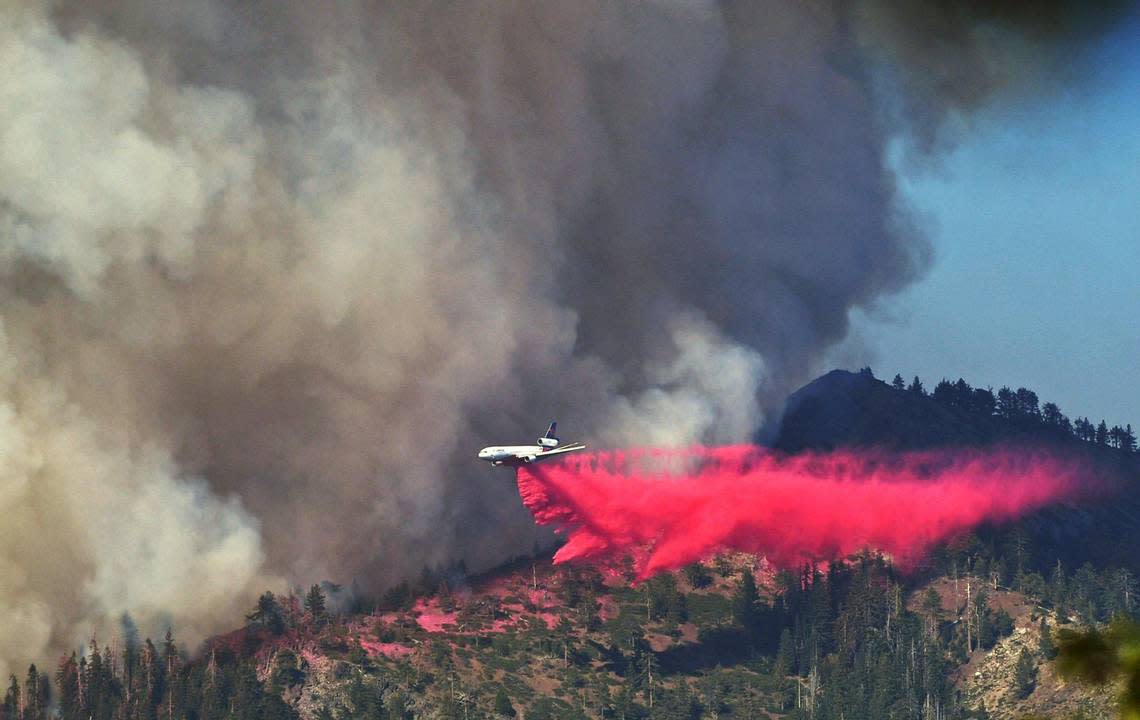Judge says Forest Service can keep using wildfire retardant even though it’s polluting water

A federal judge said the U.S. Forest Service can continue using aerial retardant to fight wildfires while it seeks a permit under the act that governs water pollution.
The judge also acknowledged in his ruling dated Friday that the Forest Service violated the Clean Water Act in certain instances when it dropped retardant in waterways. As part of the ruling, Judge Dana L. Christensen required the Forest Service to update him every six months in its pursuit of a permit that would allow the agency to drop retardant in waterways when necessary.
“The Forest Service is working diligently with the Environmental Protection Agency on a general permit for aerially delivered retardant that will allow us to continue using wildfire retardant to protect homes and communities,” said Wade Muehlhof, a spokesperson for the agency, after the ruling was filed.
The Forest Service, part of the U.S. Department of Agriculture, estimates it will take about 2 1/2 years to secure the permit. Many people from Western states who shared their experiences with the court said that taking away aerial retardant, which is used to slow the progression of fires, for even a short period of time would be catastrophic.
“No one knows the damage that these fires can cause more so than communities like mine,” said Greg Bolin, the mayor of Paradise, after the judge filed his decision. “We lost our town to one of the biggest fires in California history, so this case was very personal for us.”
The 2018 Camp Fire, the deadliest and most destructive wildfire in California’s history, burned Paradise to the ground. The town is about 20% rebuilt since then, local leaders estimate.
A group of current and former Forest Service employees had sued the agency over its use of aerial fire retardants near navigable waters, contending that it was harmful to the environment and aquatic life. The Forest Service Employees for Environmental Ethics (FSEEE) wanted the Forest Service to increase its no-drop buffer around bodies of water from 300 feet to 600 feet — a guideline the agency already agreed to in limited circumstances.
In court documents, lawyers for the Forest Service argued that this limitation would prevent the agency from dropping retardant at all.
Christensen, a judge for the U.S. District Court for the Montana district, wrote that granting the FSEEE’s request “could conceivably result in greater harm from wildfires — including to human life and property and to the environment — by preventing the (Forest Service) from effectively utilizing one of its fire fighting tools.”
What is in aerial fire retardant?
The primary fire retardant that the Forest Service has relied on is made with fertilizers from ammonium phosphates. The Department of Agriculture lists retardants as 85% water, 10% fertilizers and 5% “minor ingredients,” including colorants such as iron oxide to make the drops visible.
Some of the ingredients are not publicly broken down because the Forest Service obtains its retardant from a private company: Perimeter Solutions.
Andy Stahl, executive director of FSEEE, said in an interview last month he was worried that heavy metals such as cadmium could be in the retardant, based on the cadmium levels in the mine where the phosphate ore for the retardant is collected.
Ammonium phosphates act as a fertilizer to algae. When algae overgrows and bacteria eats its decay, it disrupts the balance of the aquatic ecosystem and can lead to a fish kill. Heavy metals such as cadmium can turn into a toxic contaminant that builds up in the fish populations.
More recently, the Forest Service started testing retardants made of inorganic salts made of magnesium chloride from a newer company, Fortress.
Has aerial fire retardant worked?
Over the past decade, the agency has dropped more retardants as fire seasons have lengthened and become more devastating, data shows. The Forest Service dropped almost 53 million gallons on federal, state and private land in 2021 compared to a 10-year annual average of about 39 million gallons.
Forest Service research shows less than 1% of retardant drops impacted U.S. waterways over the last 10 years. Of that, 80% were unintentional and 20% were based on an exception: The Forest Service can drop retardant in those areas when there’s a threat to human life or public safety and retardant could reasonably be foreseen to alleviate that threat.
“We believe retardant can be and has been delivered without compromising public health and the environment,” Muehlhof said. “We appreciate the court’s recognition of the important public safety issues involved in the litigation.”
FSEEE as part of the suit also questioned if aerial retardants really work, and if the benefits of using them outweigh the costs of chemicals contaminating water.
Studies on aerial retardants conducted by a branch of the Department of Agriculture show that they can slow a fire’s spread. But the conditions in which they are dropped have a huge impact on its efficacy; high winds, weather and the type of terrain take significant tolls on whether the retardant can properly impede a fire’s progress.
Paradise, the California Forestry Association and a dozen other localities and organizations had shared their positive views on fire retardant with the court as part of the case.
After the ruling landed, Matt Dias, the president and CEO of the California Forestry Association, said, “Fire retardant is one of the most important tools we have in our toolbox, and the Court’s decision to safeguard this tool was ultimately a decision to prioritize lives, land, businesses, and forested environments.”
Firefighting experts contend that the devastation wildfires cause can be a worse pollutant than retardant.
“Because the court rightfully chose to prioritize public safety,” said Ken Pimlott, a former director of Cal Fire, “Americans across the West can breathe a sigh of relief.”


